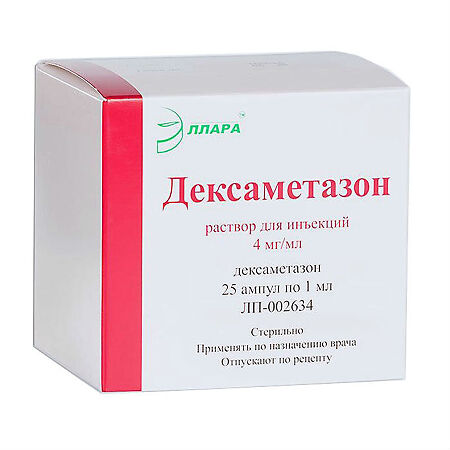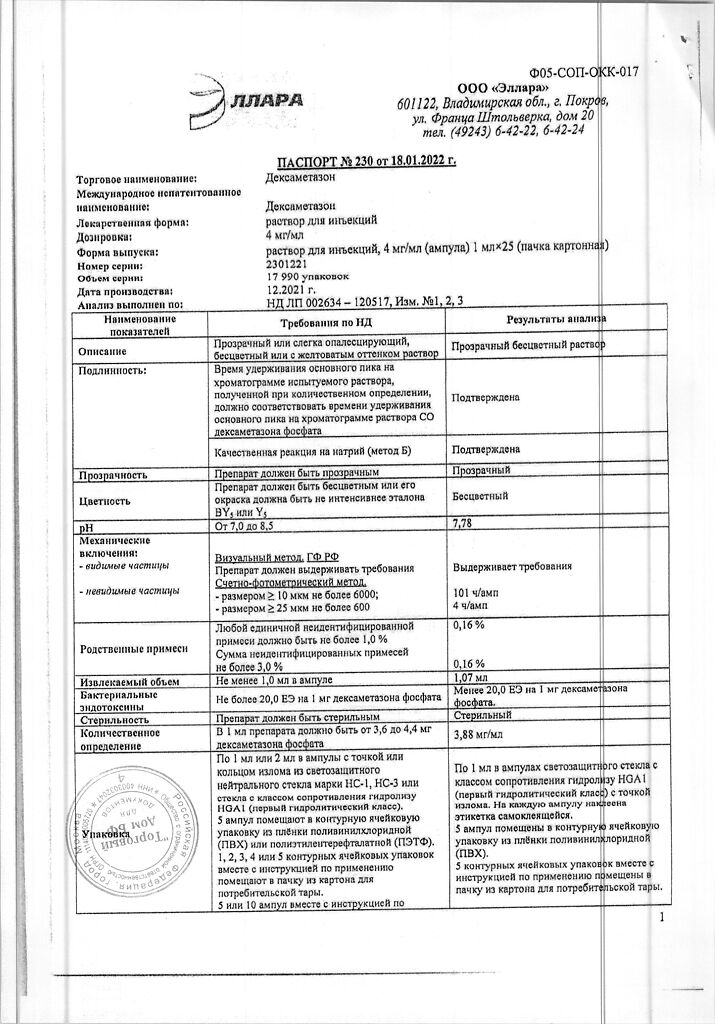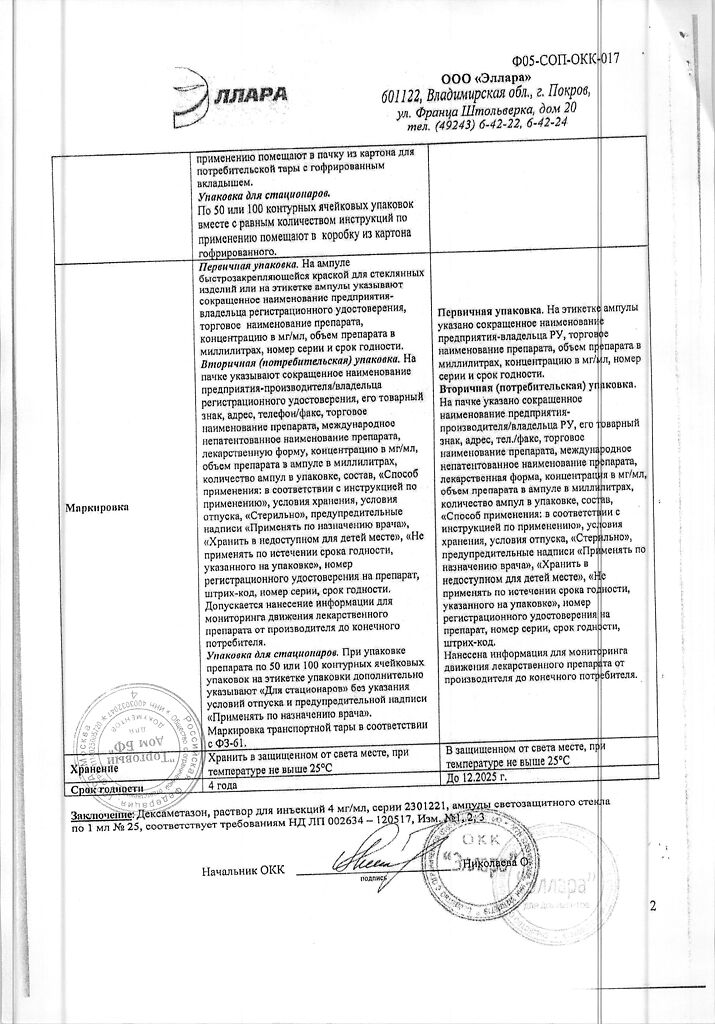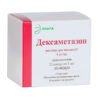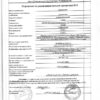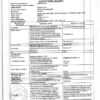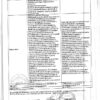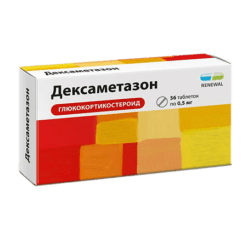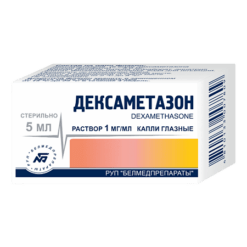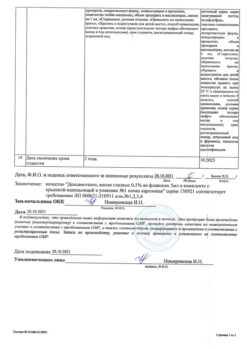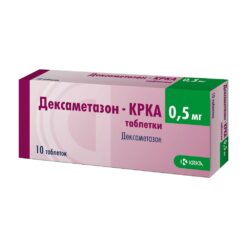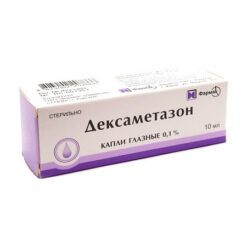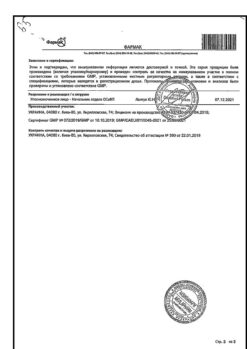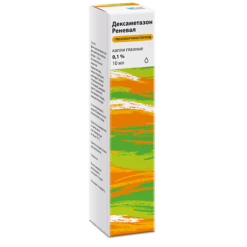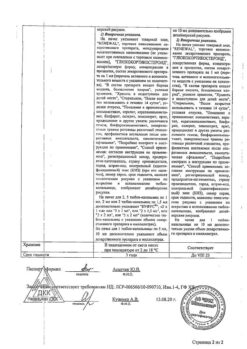No products in the cart.
Dexamethasone, 4 mg/ml 1 ml 25 pcs
€8.77 €7.31
Description
Synthetic glucocorticoid (GCS), methylated derivative of fluoroprednisolone. It has anti-inflammatory, anti-allergic and immunosuppressive effect, increases sensitivity of beta-adrenoreceptors to endogenous catecholamines.
Interacts with specific cytoplasmic receptors (receptors for GCS are in all tissues, especially in liver) with formation of complex, inducing protein formation (including enzymes regulating vital processes in cells.)
Protein metabolism: reduces the number of globulins in the plasma, increases the synthesis of albumins in the liver and kidneys (with an increase in the albumin/globulin ratio), reduces the synthesis and increases protein catabolism in muscle tissue.
Lipid metabolism: increases the synthesis of higher fatty acids and triglycerides, redistributes fat (fat accumulation occurs mainly in the shoulder girdle, face and abdomen), leads to hypercholesterolemia.
Carbohydrate metabolism: increases absorption of carbohydrates from the gastrointestinal tract, increases the activity of glucose-6-phosphatase (increased glucose flow from the liver into the blood), increases the activity of phosphoenolpyruvate carboxylase and aminotransferase synthesis (activation of gluconeogenesis), promotes hyperglycemia.
Water-electrolyte metabolism: inhibits Na+ and water in the body, stimulates K+ excretion (mineralocorticoid activity), reduces Ca+ absorption from gastrointestinal tract, reduces bone mineralization.
Anti-inflammatory effect is associated with inhibition of release of inflammatory mediators by eosinophils and mast cells, induction of lipocortin formation and reduction in number of mast cells producing hyaluronic acid, reduction of capillary permeability, stabilization of cell membranes (especially lysosomal) and organelle membranes. Acts on all stages of the inflammatory process: inhibits the synthesis of prostaglandins (Pg) at the level of arachidonic acid (lipokortin inhibits phospholipase A2, inhibits arachidonic acid liberation and inhibits the biosynthesis of endoperoxins, leukotrienes that contribute to processes of inflammation, allergy, etc.), synthesis of “pro-inflammatory cytokines” (interleukin 1, tumor necrosis factor alpha and others.The cells’ membrane is resistant to the action of various damaging factors.
The immunosuppressive effect is caused by involution of lymphoid tissue, inhibition of lymphocyte proliferation (especially T-lymphocytes), suppression of B-cell migration and interaction between T- and B-lymphocytes, inhibition of cytokine release (interleukin-1, 2, gamma interferon) from lymphocytes and macrophages and reduction of antibody formation.
Anti-allergic effect is caused by decrease of synthesis and secretion of allergy mediators, inhibition of histamine and other bioactive substances release from sensitized mast cells and basophils, decrease of circulating basophils, T- and B- lymphocytes, mast cells; suppression of lymphoid and connective tissue development, decreased sensitivity of effector cells to allergy mediators, suppression of antibody formation, changes in the body’s immune response.
In obstructive respiratory tract diseases the action is mainly caused by inhibition of inflammatory processes, prevention or reduction of mucous membrane edema, decrease of eosinophilic infiltration of submucous layer of bronchial epithelium and deposition of circulating immune complexes in bronchial mucosa, and also inhibition of erosion and mucosa desquamation. It increases sensitivity of small and medium caliber bronchial beta-adrenoreceptors to endogenous catecholamines and exogenous sympathomimetics, decreases mucus viscosity by reducing its production.
Inhibits the synthesis and secretion of ACTH and secondary – the synthesis of endogenous GCS.
Inhibits connective tissue reactions in the inflammatory process and reduces the possibility of scar tissue formation.
Specificity of action – significant inhibition of pituitary gland function and almost complete absence of mineralocorticosteroid activity.
Doses of 1-1.5 mg/day inhibit adrenal cortex function; biological half-life is 32-72 h (duration of inhibition of hypothalamic-pituitary-cortical adrenal system.
By strength of glucocorticoid activity 0.5 mg of dexamethasone corresponds to approximately 3.5 mg of prednisone (or prednisolone), 15 mg of hydrocortisone or 17.5 mg of cortisone.
Pharmacokinetics
In blood it binds (60-70%) with a specific carrier protein – transcortin. It easily passes through histohematic barriers (including hemato-encephalic and placental ones).
Metabolized in liver (mainly by conjugation with glucuronic and sulfuric acids) to inactive metabolites. T1/2 of dexamethasone from plasma is 3-5 hours.
Indications
Indications
Diseases requiring rapid-acting GCS administration and when oral administration is not possible:
Active ingredient
Active ingredient
Composition
Composition
Excipients:
Glycerol (distilled glycerin) – 22.5 mg
dinatrium edetate (trilon B) – 0.1 mg
Sodium hydrophosphate dodecahydrate (sodium phosphate divalent 12-water) – 0.8 mg
Injectable water – up to 1 ml.
How to take, the dosage
How to take, the dosage
The dosing regimen is individual and depends on the indication, the patient’s condition and his reaction to therapy. The drug is administered by IV slowly by trickle or drip (in acute and emergency conditions); by injection in m/m; local (to the pathological formation) administration is also possible. In order to prepare the solution for the IV drip infusion sodium chloride isotonic solution or 5% dextrose solution should be used.
In the acute period in various diseases and at the beginning of therapy, Dexamethasone is used in higher doses. Within a day, 4 to 20 mg of Dexamethasone may be administered 3-4 times.
Dosages of the drug for children (i.m.):
The dose of the drug in substitution therapy (for adrenal cortical insufficiency) is 0.0233 mg/kg body weight or 0.67 mg/m2 body surface area, divided into 3 doses, every 3rd day or 0.00776 to 0.01165 mg/kg body weight or 0.233 to 0.335 mg/m2 body surface area daily. For other indications, the recommended dose is 0.02776 to 0.16665 mg/kg body weight or 0.833 to 5 mg/m2 body surface area every 12-24 hours.
When effects are achieved, the dose is reduced to maintenance or until treatment is discontinued. The duration of parenteral use is usually 3-4 days, then switch to maintenance therapy with dexamethasone tablets.
Long-term use of high doses of the drug requires gradual dose reduction to prevent development of acute adrenal cortical insufficiency.
Interaction
Interaction
Possible pharmacological incompatibility of dexamethasone with other IV drugs administered – it is recommended to administer it separately from other drugs (IV bolus or through another IV, as a second solution). When mixing dexamethasone solution with heparin, a precipitate is formed.
The simultaneous administration of dexamethasone with:
Special Instructions
Special Instructions
During treatment with Dexamethasone (especially long-term) it is necessary to monitor the ophthalmologist, BP and water-electrolyte balance, as well as peripheral blood picture and blood glucose levels.
In order to reduce side effects, antacids may be prescribed, and the intake of K+ in the body should be increased (diet, potassium preparations). The food should be rich in proteins, vitamins, with restriction of fats, carbohydrates and table salt.
The action of the drug is increased in patients with hypothyroidism and cirrhosis. The drug may aggravate existing emotional instability or psychotic disorders. If a history of psychosis is indicated, Dexamethasone in high doses is prescribed under strict medical supervision.
With caution, use in acute and subacute myocardial infarction – there is a possibility of spreading the focus of necrosis, delayed formation of scar tissue and rupture of the heart muscle.
In stressful situations during maintenance treatment (e.g., surgery, trauma, or infectious diseases), the drug dose should be adjusted due to the increased need for glucocorticosteroids. Patients should be closely monitored for one year after completion of long-term therapy with Dexamethasone due to the possible development of relative insufficiency of the adrenal cortex in stressful situations.
In abrupt withdrawal, especially if high doses were previously used, withdrawal syndrome (anorexia, nausea, lethargy, generalized musculoskeletal pain, generalized weakness) and exacerbation of the disease for which Dexamethasone was prescribed may occur.
Vaccination should not be performed during treatment with Dexamethasone due to a decrease in its effectiveness (immune response).
When prescribing Dexamethasone for intercurrent infections, septic conditions and tuberculosis, bactericidal antibiotics must be treated at the same time.
In children during long-term treatment with Dexamethasone the growth and development dynamics should be closely monitored. Children who have been in contact with patients with measles or chickenpox during treatment are prescribed specific immunoglobulins prophylactically.
Due to the weak mineralocorticoid effect for replacement therapy in adrenal insufficiency Dexamethasone is used in combination with mineralocorticoids.
In diabetic patients, blood glucose levels should be monitored and therapy should be adjusted if necessary.
The radiological control of the bone and joint system (pictures of the spine, hand) is indicated.
In patients with latent renal and urinary tract infections, Dexamethasone may cause leukocyturia, which may be of diagnostic value.
Dexamethasone increases metabolites of 11- and 17-oxyketocorticosteroids.
Features
Features
Contraindications
Contraindications
For short-term use for vital signs, the only contraindication is hypersensitivity to dexamethasone or components of the drug.
In children during growth, GCS should only be used for absolute indications and under the close supervision of the attending physician.
The drug should be prescribed with caution in the following diseases and conditions:
Side effects
Side effects
Dexamethasone is usually well tolerated. It has low mineralocorticoid activity, i.e. its effect on water-electrolyte metabolism is small. As a rule, low and medium doses of Dexamethasone do not cause sodium and water retention in the body and increased potassium excretion. The following side effects have been described:
Endocrine system side effects: Decreased glucose tolerance, steroid diabetes mellitus or manifestation of latent diabetes mellitus, depression of adrenal function, Icenko-Cushing’s syndrome (moon-shaped face, pituitary-type obesity, hirsutism, increased blood pressure, dysmenorrhea, amenorrhea, muscle weakness, stretch marks), delayed sexual development in children.
Digestive system disorders: nausea, vomiting, pancreatitis, steroid gastric and duodenal ulcer, erosive esophagitis, gastrointestinal bleeding and perforation of the gastrointestinal wall, increased or decreased appetite, digestive disorders, flatulence, hiccups. In rare cases – increased activity of liver transaminases and alkaline phosphatase.
Cardiovascular system disorders: arrhythmias, bradycardia (up to cardiac arrest); development (in predisposed patients) or increase of severity of heart failure, electrocardiogram changes typical for hypokalemia, increased arterial pressure, hypercoagulation, thrombosis. In patients with acute and subacute myocardial infarction – expansion of the focus of necrosis, delayed formation of scar tissue, which may lead to rupture of the heart muscle.
Nervous system disorders: delirium, disorientation, euphoria, hallucinations, manic-depressive psychosis, depression, paranoia, increased intracranial pressure, nervousness or anxiety, insomnia, dizziness, vertigo, cerebellar pseudotum, headache, seizures.
Senses: posterior subcapsular cataract, increased intraocular pressure with possible damage to the optic nerve, tendency to develop secondary bacterial, fungal or viral eye infections, trophic changes of the cornea, exophthalmos, sudden vision loss (when parenteral administration in the head, neck, nasal cavities, scalp may cause deposition of crystals of the drug in the vessels of the eye).
Metabolic disorders: increased calcium excretion, hypocalcemia, weight gain, negative nitrogen balance (increased protein breakdown), increased sweating.
The mineralocorticoid-induced fluid and sodium retention (peripheral edema), hypsnatronemia, hypokalemic syndrome (hypokalemia, arrhythmia, myalgia or muscle spasm, unusual weakness and fatigue).
Musculoskeletal system disorders: growth retardation and ossification processes in children (premature closure of epiphyseal growth zones), osteoporosis (very rarely – pathological bone fractures, aseptic necrosis of the humeral and femoral head), rupture of muscle tendons, steroid myopathy, decrease of muscle mass (atrophy).
Skin and mucous membranes: delayed wound healing, petechiae, ecchymosis, skin thinning, hyper- or hypopigmentation, steroid acne, stretch marks, tendency to pyoderma and candidiasis.
Allergic reactions: skin rash, itching, anaphylactic shock, local allergic reactions.
Local when parenteral administration: burning, numbness, pain, tingling at the injection site, infection at the injection site, rarely – necrosis of the surrounding tissues, scar formation at the injection site; atrophy of the skin and subcutaneous tissue in case of injection (injection into the deltoid muscle is especially dangerous).
Others: development or exacerbation of infections (the appearance of this side effect is promoted by co-administration of immunosuppressants and vaccination), leukocyturia, “flushes” of blood to the face, “withdrawal” syndrome.
Overdose
Overdose
The side effects described above may worsen.
The dose of Dexamethasone should be reduced. Treatment is symptomatic.
Similarities
Similarities
Additional information
| Shelf life | 3 years. Do not use after the expiration date stated on the package. |
|---|---|
| Manufacturer | Ellara, Russia |
| Medication form | solution for injection |
| Brand | Ellara |
Other forms…
Related products
Buy Dexamethasone, 4 mg/ml 1 ml 25 pcs with delivery to USA, UK, Europe and over 120 other countries.

